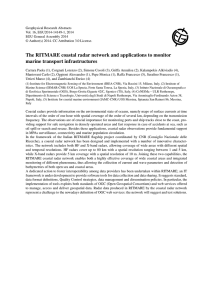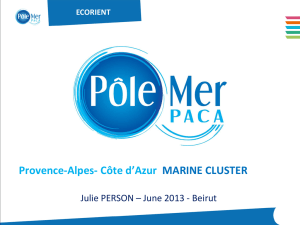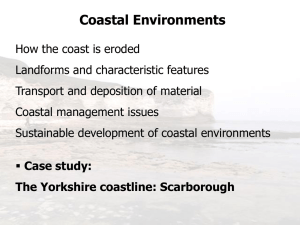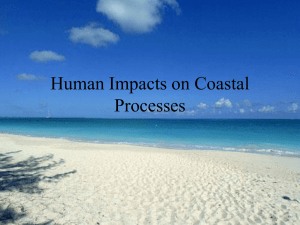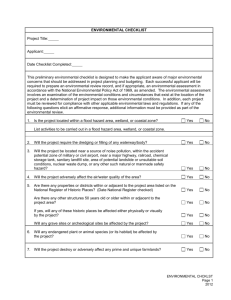Megacities proposal
advertisement
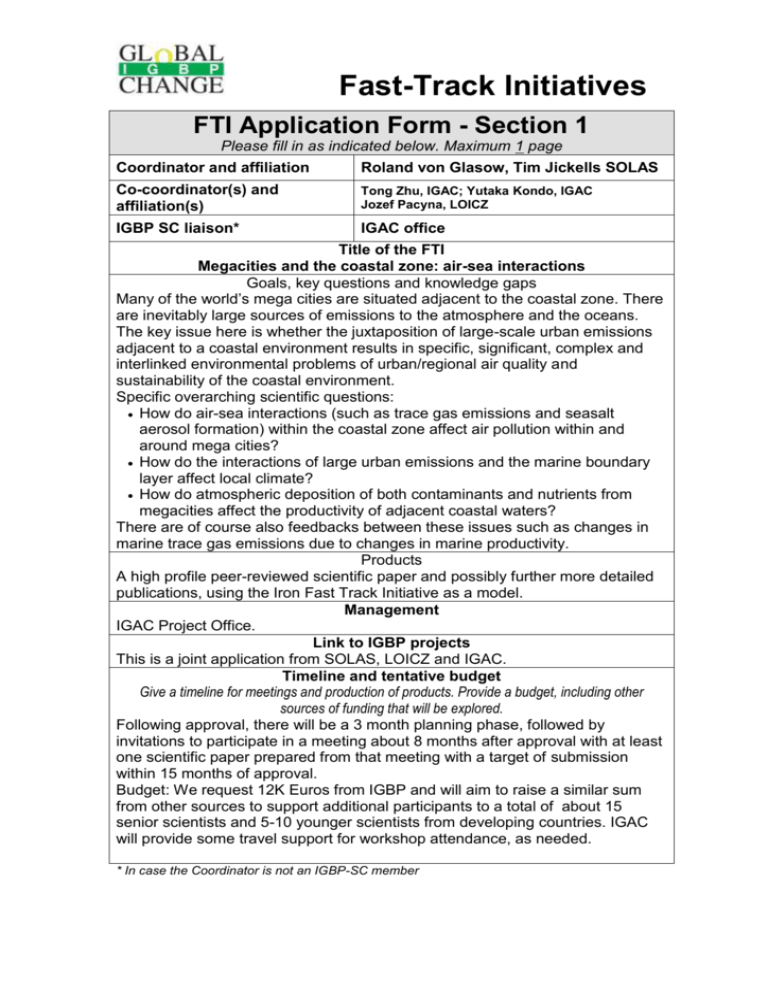
Fast-Track Initiatives FTI Application Form - Section 1 Please fill in as indicated below. Maximum 1 page Coordinator and affiliation Roland von Glasow, Tim Jickells SOLAS Co-coordinator(s) and affiliation(s) Tong Zhu, IGAC; Yutaka Kondo, IGAC Jozef Pacyna, LOICZ IGBP SC liaison* IGAC office Title of the FTI Megacities and the coastal zone: air-sea interactions Goals, key questions and knowledge gaps Many of the world’s mega cities are situated adjacent to the coastal zone. There are inevitably large sources of emissions to the atmosphere and the oceans. The key issue here is whether the juxtaposition of large-scale urban emissions adjacent to a coastal environment results in specific, significant, complex and interlinked environmental problems of urban/regional air quality and sustainability of the coastal environment. Specific overarching scientific questions: How do air-sea interactions (such as trace gas emissions and seasalt aerosol formation) within the coastal zone affect air pollution within and around mega cities? How do the interactions of large urban emissions and the marine boundary layer affect local climate? How do atmospheric deposition of both contaminants and nutrients from megacities affect the productivity of adjacent coastal waters? There are of course also feedbacks between these issues such as changes in marine trace gas emissions due to changes in marine productivity. Products A high profile peer-reviewed scientific paper and possibly further more detailed publications, using the Iron Fast Track Initiative as a model. Management IGAC Project Office. Link to IGBP projects This is a joint application from SOLAS, LOICZ and IGAC. Timeline and tentative budget Give a timeline for meetings and production of products. Provide a budget, including other sources of funding that will be explored. Following approval, there will be a 3 month planning phase, followed by invitations to participate in a meeting about 8 months after approval with at least one scientific paper prepared from that meeting with a target of submission within 15 months of approval. Budget: We request 12K Euros from IGBP and will aim to raise a similar sum from other sources to support additional participants to a total of about 15 senior scientists and 5-10 younger scientists from developing countries. IGAC will provide some travel support for workshop attendance, as needed. * In case the Coordinator is not an IGBP-SC member Fast-Track Initiatives FTI Application Form - Section 2 Please fill in as indicated below. Maximum 3 pages Goals, key questions and knowledge gaps Between 1950 and 2000, the world’s population increased from ~2.5 billion to ~6 billion, while the fraction of people living in urban areas increased from ~30% to 50%. Of the roughly three billion people now living in urban areas, about 13% live in low elevation coastal zones, and most of the world’s mega-cities are adjacent to the coastal zone. Rapid economic growth coupled with this trend towards urbanization has implications for coastal zones via atmospheric and water-borne pollutants, physical re-structuring of the coastline and other management practices. The economies of these cities, in turn, are often dependent on the health of ecosystems in the adjacent coastal area, such as through fisheries and tourism. The interaction between atmospheric pollution associated with megacities and the sustainability of the adjacent coastal ecosystem is an understudied topic that presents exciting scientific challenges and addresses issues of very direct societal concern. Coastal ecosystems’ highly complex and specialized nature makes them both biologically productive and highly sensitive to human activities. They are currently subject to multiple environmental stresses including those from runoff that have been relatively well characterised scientifically, (e.g. sediment sewage, solid waste, high nutrient loads, synthetic organic chemicals, oil, and pathogens run off) even if the societal solutions to these pressures are still poorly developed. These pressures result in eutrophication and deterioration of water quality, which have adverse effects on coastal ecosystems and their living resources. Continued urbanization along coastal regions will only increase these pressures. The impact of atmospheric emissions from mega-cities on adjacent coastal waters has been less studied, as has the reciprocal issue of the impact of emissions from coastal waters on urban air quality. This is the focus of this proposed Fast Track Initiative. The science involved crosses boundaries between IGBP core projects and hence this joint proposal from members of the IGAC, SOLAS and LOICZ communities. Since many of the world’s mega-cities are situated adjacent to the coastal zone, there are inevitably large sources of emissions to the atmosphere and deposition to the adjacent coastal system. These emissions include nutrient sources, such as fixed nitrogen, and contaminants such as trace metals and persistent organic contaminants. The synergistic and antagonistic effects of the deposition of such a cocktail are essentially unknown. The scale of impacts from urban emissions is poorly understood and may be very different in different regions. The impacts of this deposition have the potential to exacerbate environmental stresses on coastal ecosystems for a considerable area around mega cities, adding to the impact of polluted runoff, which is often more local. A range of potential environmental problems can arise from such stresses including hypoxia, harmful algal blooms and the loss of coastal protection from habitats such as coral reefs and mangroves. These coastal waters are in many cases valuable resources for the local population providing food, tourism, recreation, transport, trade and possibly water supply via desalination. The emissions of gases and seasalt particles from the coastal zone have the Fast-Track Initiatives potential to modify the atmosphere over the mega city affecting air quality. For example, the interaction of halogens released from seasalt can alter photochemical ozone cycling. Also the interaction of urban atmospheric emissions and seasalt can affect regional climate via changes in cloud condensation nuclei number and size distribution. These interactions between marine and urban emissions may therefore result in fundamentally different atmospheric chemistry than that arising from emissions from inland urban areas. These interactions have the potential to significantly reduce urban air quality in areas already subject to poor air quality and associated societal health risks, exacerbating impacts from other global change pressures such as climate change. Furthermore, the complex chemistry of ozone formation means that the impacts of interactions between megacity emissions and seasalt on ozone, as well as climate impacts, are regional scale issues and affect areas beyond the megacity, by for instance reducing crop yields and thereby producing additional societal pressures. This fast track initiative aims to address the key issue of whether the juxtaposition of large scale urban emissions adjacent to a coastal environment results in specific, significant, complex and interlinked environmental problems both in terms of urban air quality and sustainability of the coastal environment. Understanding these affects will be important for informing air and water pollutant mitigation strategies at local and regional scales. Specific overarching scientific questions. How do air-sea interactions (such as trace gas emissions and seasalt aerosol formation) within the coastal zone affect air pollution within mega-cities? The scale of emissions and the key role of halogens in ozone cycling mean that these regions may have a unique chemical environment. How do the interactions of large urban emissions and the marine boundary layer affect local climate? There is evidence that the interaction of marine and urban particulate matter can significantly alter cloud condensation nuclei properties and hence cloud formation and local climate, with implications for both gas-phase chemistry and aerosol micro-physics. How do atmospheric deposition of both contaminants and nutrients from megacities affect the productivity of adjacent coastal waters? The atmospheric emissions from mega cities will be characterised in terms of the input of nutrients, such a fixed nitrogen, and of contaminants. These are deposited down wind of the city and potentially impact the marine environment, causing eutrophication type problems such as harmful algal blooms in regions where large populations may be dependent on the marine environment for environmental services such as food, recreation, tourism, transport and possibly water via desalination. There are of course feedbacks between these issues such as changes in marine trace gas emissions due to changes in marine productivity. This fast track initiative cannot of course solve all of these scientific questions. The goal is rather to consider these issues within an integrative interdisciplinary framework, identify the major societal issues and identify the key research needs in terms of both scientific understanding and environmental management. Inevitably these issues are strongly dependent upon the geographic setting of particular megacities. These issues will therefore need to be addressed both in terms of the Fast-Track Initiatives fundamental understanding of the scientific issues, scaling up with models and also case studies. The approach to meeting these goals will be to hold one meeting to which we invite about 15 scientific specialists with diverse experience addressing particular aspects of this issue, plus 10 junior scientists, most from developing scientific countries. Participants will prepare material ahead of time, present it at the meeting and then discuss it over ~3 days. The meeting goal is to produce a high quality, high profile peer reviewed publication, and the writing of this paper may require a few smaller follow-on meetings. There may also be additional more detailed papers. These outputs will raise the profile of the scientific challenges in this field, identify the key issues involved and prioritise research needs. Products A high-profile peer-reviewed scientific paper and possibly further more detailed publications, using the example of the Iron Fast Track Initiative as a model. Expected outcomes At least one high-profile, peer reviewed publication reviewing this important area and possibly additional spin off papers. The main publication will aim to outline the scientific understanding in this area, identify key unknowns and also the policy challenges arising from this work. Additional specialised papers may also be produced. At the broader level we hope to catalyse interest in the development of this field of study which is highly interdisciplinary (hence the three IGBP programmes involvement) and of high societal relevance. Participants List the participants with their expertise, country and gender Full list to be prepared during the initial 3 month phase by consultation amongst coordinators. Names so far suggested include the following (most of whom have not yet been approached). Greg Carmichael (USA), Maria Christina Facchini (Italy), Roland von Glasow (UK), Tim Jickells (UK), Maria Kanakidou (Greece), Yutaka Kondo (Japan), Dileep Kumar (India), Mark Lawrence (Germany), Neng-Huei Lin (Taiwan), Liana McManus (USA), Alice Newton (Portugal), Josef Pacyna (Norway), Joan Willey (USA), Daniel Rosenfeld (Israel), Sybil Seitzinger (USA), Vanisa Surapipith (Thailand), Maren Voss (Germany), Tong Zhu (China), Younger scientists would be identified later. Interaction with stakeholders and the user community The three IGBP projects core offices will lead this component via their own stakeholder and user community networks. Other issues Describe/explain any other aspect of relevance to the proposal



